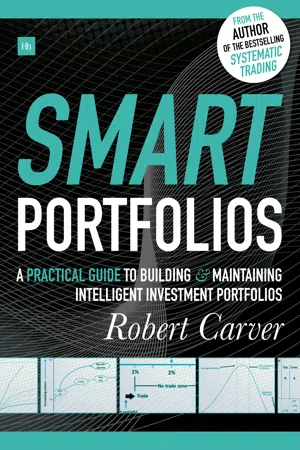
Smart Portfolios
A practical guide to building and maintaining intelligent investment portfolios
- English
- ePUB (mobile friendly)
- Available on iOS & Android
Smart Portfolios
A practical guide to building and maintaining intelligent investment portfolios
About This Book
Smart Portfolios is about building and maintaining smart investment portfolios. At its heart are the three key questions every investor needs to answer:1. What to invest in.2. How much to invest.3. When to make changes to a portfolio.Author Robert Carver addresses these three areas by providing a single integrated approach to portfolio management. He shows how to follow a step-by-step process to build a multi-asset investment portfolio, and how to rebalance the portfolio efficiently. He covers both investment in collective funds like ETFs, and also direct investment in individual equities.Important features include:-- Why forecasting future returns is so difficult, and how to account for uncertainty when making investment decisions.-- How to accurately calculate the true costs of an investment, including costs that you may not even be aware of.-- How to select the best ETF for each asset class.-- How to compare the costs and other features of different ETFs.-- How to select individual shares.-- Calculating the number of shares needed for adequate diversification.-- How to use systematic forecasting algorithms to adjust portfolio allocations.-- How to cut trading costs through smart rebalancing strategies and execution tactics.Robert Carver also explains how to blend assets with different levels of risk, and how to construct portfolios that suit the level of risk that the investor can cope with. Smart Portfolios is detailed, comprehensive, and full of practical methods, rules of thumb and techniques, all fully explained with examples. It is intended for professional investors worldwide, including financial advisors, private bankers, wealth managers and institutional funds; as well as experienced private investors.
Frequently asked questions
Information
Part One: Theory of Smart Portfolios
Chapter One: What is the Best Portfolio?
Chapter overview
- Geometric mean return: The type of averaging to use when evaluating levels of future and past returns.
- Expectations: Investment is about what we expect to happen in the future. How do we assess what outcomes are likely?
- Risk and time horizon: The best portfolio will depend on your tolerance for risk: to what degree you can cope with potential losses over different time periods.
- Total return and dividends: Does it matter whether you get your return from price rises, dividends, or both?
- After costs: All investments involve paying costs of various kinds; you need to take these into account when evaluating different investments.
- Real returns: It’s important to think about the effect of inflation: real returns are returns with inflation deducted.
- Currency: The point of investment is to provide an income stream or capital for future expenditure. Therefore you need to worry about portfolio growth in the currency in which you will spend money in the future. But the best portfolios are widely diversified, and you can’t get international diversification without exposing your portfolio to movements in foreign exchange rates. Should you protect yourself against adverse currency movements?
- Absolute returns versus embarrassment and relative returns: Many investors are concerned about their performance relative to others. The potential embarrassment from doing something different to the consensus and getting it wrong is hard to ignore.
- Non-financial considerations: All of these are purely financial considerations, however modern day investors are increasingly thinking about the moral and ethical consequences of their investment decisions as well.
Geometric mean return
Table of contents
- Contents
- About the author
- Note about this eBook edition
- Preface
- Introduction
- Prologue: What do we know?
- Part One: Theory of Smart Portfolios
- Chapter One: What is the Best Portfolio?
- Chapter Two: Uncertainty and Investment
- Chapter Three: Trying to Find the Best Portfolio
- Chapter Four: Simple, Smart, and Safe Methods to find the Best Portfolio (Without Costs)
- Chapter Five: Smart Thinking About Costs
- Chapter Six: The Unknown Benefits and Known Costs of Diversification
- Part Two: Creating Smart Portfolios
- Chapter Seven: A Top-Down Approach to Building Smart Portfolios
- Chapter Eight: Asset Classes
- Chapter Nine: Alternatives
- Chapter Ten: Equities Across Countries
- Chapter Eleven: Equities Within Countries
- Chapter Twelve: Bonds
- Chapter Thirteen: Putting It All Together
- Part Three: Predicting Returns
- Chapter Fourteen: Predicting Returns and Selecting Assets
- Chapter Fifteen: Are Active Fund Managers Really Geniuses? And is Smart Beta Really Smart?
- Part Four: Smart Rebalancing
- Chapter Sixteen: The Theory of Rebalancing
- Chapter Seventeen: Portfolio Maintenance
- Chapter Eighteen: Portfolio Repair
- Epilogue
- Glossary
- Appendices
- Appendix A: Resources
- Appendix B: Cost and Return Statistics
- Appendix C: Technical Stuff
- Acknowledgements
- Reference